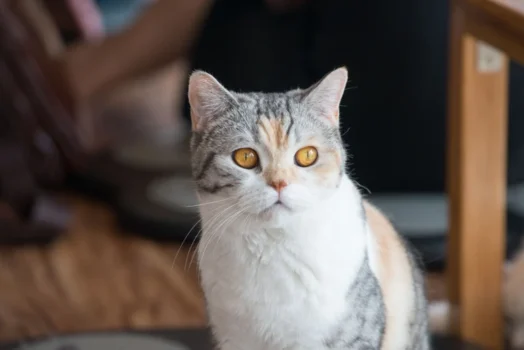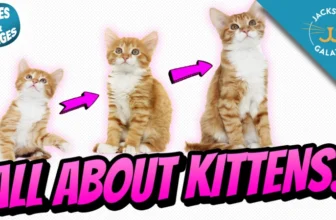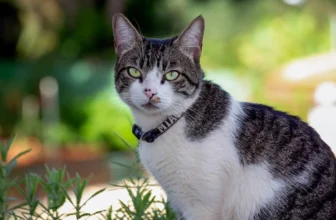As cat lovers, we’re always fascinated by the beauty and uniqueness of different cat breeds. One breed that stands out for its distinctive coat and hearty demeanor is the American Wirehair. However, have you ever wondered how this breed came to be? In this article, we’ll explore the impact of selective breeding on American Wirehair genetics, the importance of genetic diversity in cat breeds, current genetic issues and concerns for the American Wirehair breed, and the potential future of American Wirehair genetics. So, let’s whisker our way into the world of feline genetics!
What is Selective Breeding?

Selective breeding is a fascinating and complex subject that has been around for centuries. In simple terms, it involves selecting the best animals with desirable traits and breeding them to produce offspring that also exhibit those traits. This process has been used for centuries to develop a wide variety of domesticated plants and animals, including cats. In relation to American Wirehair genetics, selective breeding has played a significant role in shaping the traits and characteristics that make this breed so unique. To learn more about the history and impact of selective breeding on American Wirehair genetics, continue reading below. Additionally, if you’re interested in learning about genetic disorders in the breed or how to preserve genetic diversity, be sure to check out our articles on genetic disorders in the American Wirehair breed and genetic diversity in American Wirehair breeding.
The Basics of Selective Breeding
Selective breeding is the intentional process of breeding animals with specific desirable traits in order to produce offspring with those traits. Breeders choose the parents based on certain characteristics they want the offspring to inherit and then mate them. This process is repeated over several generations, resulting in a breed of animals with consistently desirable characteristics.
One of the important aspects of selective breeding is genetic variation. Genetic variation is the variation in the DNA sequence that makes each organism unique. It can result in variation in physical appearance, behavior, and health traits. The more genetically diverse a population is, the more likely it is that some individuals will have traits that are well-suited for survival in a changing environment.
In order to achieve the desired traits, breeders must carefully select which animals to breed. They look for individuals that have desirable traits, such as a specific coat color or length. Once the desirable trait is identified, breeders will breed individuals with that trait together, eventually creating a population of animals that all have that desirable trait.
However, selective breeding can have unintended consequences. Overuse of a specific breeding line for a particular trait can lead to genetic mutations, health problems, and reduced genetic diversity in the overall population. This is a concern for the American Wirehair breed, as it has a small gene pool compared to some other breeds. Without careful attention to breeding practices, the population could become vulnerable to genetic disorders and illnesses.
To learn more about genetics and American Wirehairs, check out our article on Genetics in American Wirehairs and our article on Genetic Testing and Breeding in American Wirehairs.
How Selective Breeding has affected American Wirehair Genetics
Selective breeding has had a significant impact on the genetics of American Wirehair cats. By choosing specific cats with desirable traits to breed, and selectively eliminating those that do not meet breed standard guidelines, breeders have created a distinct and unique breed.
Positive Effects
Through the careful practice of selective breeding, the American Wirehair breed has been able to develop a number of unique characteristics that set it apart from other cat breeds. These include its distinct, wiry coat, which is caused by a dominant gene mutation, as well as its friendly and affectionate disposition.
In addition to these physical and behavioral traits, selective breeding has also helped to address health concerns in the breed. By carefully selecting breeding pairs and conducting thorough genetic testing, breeders have been able to eliminate or greatly reduce the prevalence of certain genetic health conditions in the American Wirehair breed population.
Negative Effects
However, while selective breeding has led to many positive outcomes for the American Wirehair breed, it has also had negative effects on its genetics. One of the main concerns is the potential for inbreeding, which can lead to the expression of recessive genetic traits that may be harmful to the health of the breed.
Inbreeding can also lead to a lack of genetic diversity within the breed, which can limit the ability of breeders to address health concerns and make improvements to the breed’s genetics over time. Additionally, the practice of selectively breeding for certain physical traits – such as the American Wirehair’s wiry coat – can inadvertently lead to the expression of other, undesirable traits as well.
To address these concerns, many breeders are now working to make their breeding programs more sustainable and responsible. This may involve conducting more extensive genetic testing, tracking and analyzing breed health data, and carefully selecting breeding pairs to maximize genetic diversity and minimize the risk of inbreeding.
| Positive Effects | Negative Effects |
|---|---|
| Distinct, wiry coat | Potential for inbreeding |
| Friendly and affectionate disposition | Lack of genetic diversity |
| Addressed health concerns | Possible expression of undesirable traits |
The Importance of Genetic Diversity in Cat Breeds
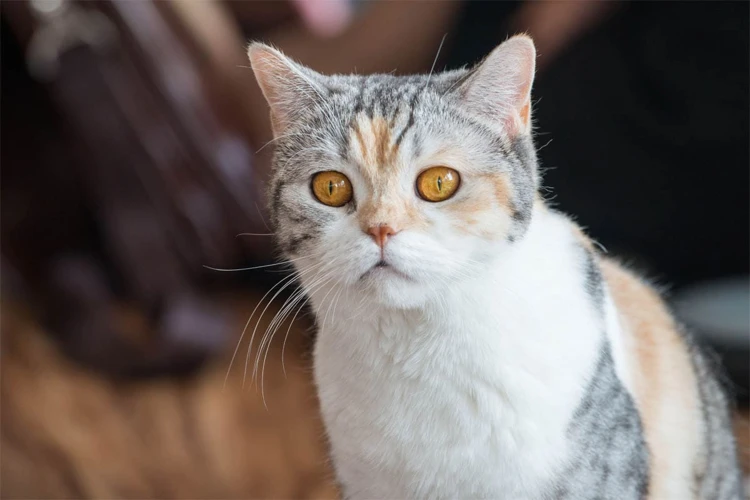
As the world of cat breeding continues to thrive, it’s important to recognize the value of genetic diversity within cat breeds. Without a varied gene pool, inbreeding and genetic disorders can become all too common, threatening the health and longevity of cat breeds such as the American Wirehair. Understanding why genetic diversity is key, and how we can preserve it in the American Wirehair breed, is crucial for their future success and well-being. Let’s explore this topic further.
Why Genetic Diversity is key
Why Genetic Diversity is Key:
Genetic diversity is vital to the survival and sustainability of any species, including cats. Without genetic diversity, there is a higher risk of the expression of harmful traits and diseases. In the cat breeding world, this is particularly impactful as a lack of genetic diversity can lead to a breed becoming predisposed to a particular health concern, such as HCM in Maine Coons.
Benefits of genetic diversity:
| Benefit | Description |
|---|---|
| Enhanced Disease Resistance | Genetic diversity allows for a variety in immune systems, making it less likely for contagious diseases to wipe out an entire population. |
| Improved Fitness | Increased variation within a gene pool can provide individuals with more advantageous traits that make them better adapted to their environment. |
| Greater Adaptability | A gene pool with a wider range of genes can better respond to environmental pressures and changing conditions. |
Maintaining a genetically diverse population is important for the American Wirehair breed. In order to ensure the breed’s long-term health and vitality, breeders must prioritize genetic diversity when selecting which cats to mate. This means looking beyond just physical appearance when selecting breeding pairs and taking into consideration genetic health and variation as well.
Strategies for maintaining genetic diversity:
| Strategy | Description |
|---|---|
| Outcrossing | Outcrossing involves breeding cats from outside the breed to increase genetic variation. |
| Linebreeding | Linebreeding involves breeding closely related cats, such as grandfather to granddaughter or uncle to niece, to maintain desirable traits while minimizing the risk of inbreeding. |
| Importing cats | Importing cats from other countries can introduce new genetic variation to a breed. |
By incorporating these strategies into breeding plans, breeders can help to maintain genetic diversity within the American Wirehair breed, which will ultimately result in healthier, more robust cats.
How to Preserve Genetic Diversity in the American Wirehair Breed
Preserving genetic diversity is crucial when it comes to maintaining the health and long-term viability of the American Wirehair breed. Here are a few ways breeders can achieve this goal:
- Outcrossing: One way to increase genetic diversity is by outcrossing, which involves breeding American Wirehairs with cats that are not part of the breed. However, it’s important to ensure that the outcrossed cats have similar physical and behavioral traits as the American Wirehair, and that the breeder is aware of potential health issues that may arise.
- Linebreeding: Linebreeding involves breeding cats that are closely related to each other, such as siblings or cousins. While it can increase the chances of passing on desirable traits, it can also increase the likelihood of passing on genetic defects. It’s important to balance linebreeding with outcrossing to maintain genetic diversity.
- Retaining older bloodlines: By retaining older bloodlines in the breeding program, breeders can help preserve genetic diversity. This means that breeders should avoid overusing popular cats that dominate the gene pool, and instead strive to maintain a healthy mix of various bloodlines.
- Genetic testing: Breeders can use genetic testing to identify potential carriers of inherited diseases and avoid breeding cats that are at risk of passing on these diseases. By doing so, they can help reduce the incidence of genetic diseases among the American Wirehair population.
- Open communication: It’s important for breeders to openly communicate with each other about genetics, especially when it comes to sharing information about potential health issues and bloodlines. This helps prevent inbreeding and ensures that all breeders are working together to preserve genetic diversity in the American Wirehair breed.
By utilizing these methods, breeders can help preserve the genetic diversity of the American Wirehair breed, ensuring its longevity and health for generations to come.
Current Genetic Issues and Concerns for the American Wirehair Breed
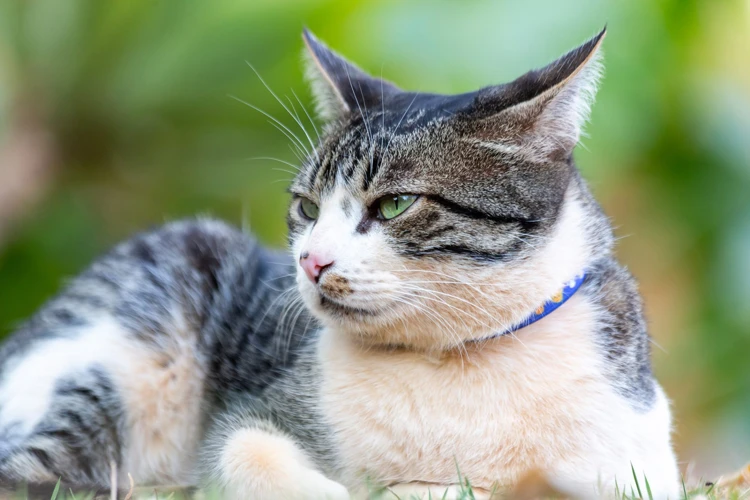
As with any selectively bred animal, there can be genetic issues and concerns that arise within the American Wirehair cat breed. The breeding process narrows the gene pool, which can lead to inherited diseases and disorders. These issues must be carefully monitored and addressed by breeders and geneticists to ensure the health and longevity of the American Wirehair breed. Let’s take a closer look at some of the current genetic issues and concerns facing these beloved felines.
Genetic Disorders in the American Wirehair Breed
Selective breeding of cats has been undertaken for centuries to develop certain desired traits in the breed. However, what are often overlooked are the possible genetic disorders that may come along with this process. This holds true for the American Wirehair breed as well. While they are generally a healthy breed, there are still some possible genetic disorders to be aware of.
Let’s take a closer look at some of the potential genetic disorders in the American Wirehair breed:
| Disease/Disorder | Description |
|---|---|
| Feline Hypertrophic Cardiomyopathy (HCM) | An inherited heart disorder that affects the muscles of the heart, causing it to become stiff and less able to pump blood effectively, eventually leading to heart failure. |
| Polycystic Kidney Disease (PKD) | A hereditary condition that causes fluid-filled sacs (cysts) to form in the kidneys, leading to kidney damage or failure over time. |
| Feline Lower Urinary Tract Disease (FLUTD) | A group of conditions affecting the lower urinary tract (bladder, urethra) which may cause symptoms such as straining to urinate, bloody urine, and frequent urination, among others. |
| Retinal Dysplasia | A genetic condition that affects the development of the retina, causing visual impairment or blindness. |
It is important to note that not all American Wirehairs will develop these disorders, and the likelihood can be reduced through careful breeding methods. While there has been some genetic testing done on this breed, further research is necessary to fully understand and minimize the risk of genetic disorders. It is also recommended that cat owners of this breed seek regular check-ups with a veterinarian to identify potential issues early on.
The potential for genetic disorders is an important factor to consider when breeding any cat breed, including the American Wirehair. It’s important for breeders to prioritize the health and wellbeing of the cats they are breeding, rather than solely focusing on physical appearance or other desirable traits.
The Need for Increased Genetic Testing and Research
As with any breed of cat, American Wirehairs are not immune to genetic disorders. While these disorders may be inherited from a cat’s parents, they may also be the result of a genetic mutation. It is crucial to conduct thorough genetic testing and research to uncover any potential disorders and take steps to mitigate them.
The Importance of Genetic Testing
One crucial step towards ensuring the health and longevity of the American Wirehair breed is genetic testing. By conducting genetic testing on cats, breeders can identify potential carriers of genetic disorders and avoid breeding them with other cats. This helps to prevent the spread of genetic disorders and maintain the breed’s overall health.
The Benefits of Genetic Research
In addition to genetic testing, research is also important in uncovering potential genetic disorders. By conducting research on the breed’s DNA, scientists and breeders alike can identify potential mutations and develop plans to mitigate the effects of these mutations. This could include avoiding breeding cats that carry certain genetic mutations, developing treatments for specific disorders, or even adjusting breeding practices to promote genetic diversity.
The Need for Increased Effort
While some genetic testing is already conducted within the American Wirehair breeding community, there is a need for increased effort in this area. As the breed’s popularity grows and more people become involved in breeding, it becomes even more important to maintain the breed’s genetic health. One potential way to accomplish this is to create a centralized database of genetic testing results that breeders can easily access to make informed decisions about breeding practices.
| Pros | Cons |
|---|---|
| Can identify and prevent genetic disorders within the breed | Can be expensive and time-consuming |
| May lead to advancements in treatments for genetic disorders | May result in breeders avoiding certain cats due to genetic mutations |
| Helps ensure the overall health and longevity of the breed | May limit breeding options and reduce genetic diversity |
While there may be some drawbacks to increased genetic testing and research, the benefits of maintaining a healthy and genetically diverse American Wirehair breed far outweigh the potential cons. By working together and dedicating resources to these efforts, we can help ensure that future generations of American Wirehairs are healthy and happy.
The Future of American Wirehair Genetics
As we continue to evolve the American Wirehair breed through selective breeding and genetics, it’s important to consider what the future holds for this unique species. With advancing technology and new developments in the field, there are both exciting opportunities and challenges that lie ahead. Let’s take a closer look at what the future may hold for American Wirehair genetics.
Potential Changes in Purrfect Pedigrees
The future of American Wirehair Genetics is full of potential changes in Purfect Pedigrees. As breeders and pet owners become more educated about the importance of genetic diversity and potential health issues in purebred cats, there may be a shift towards less emphasis on having a “perfect” pedigree and more emphasis on maintaining genetic health.
1. Introduction of New Bloodlines: One potential change that may occur in Purrfect Pedigrees is the introduction of new bloodlines. Breeders may start to cross American Wirehairs with other breeds, such as the British Shorthair, to increase genetic diversity. However, this must be done carefully to ensure that desirable traits are not lost in the process.
2. Increased Genetic Testing: Another potential change is the increase in the use of genetic testing to screen for health issues. As more genetic tests become available for cat breeds, breeders may start to incorporate testing into their breeding programs to reduce the risk of passing on genetic disorders.
3. Greater Emphasis on Health and Temperament: With more awareness about the potential health risks associated with selective breeding, there may be a shift towards placing greater emphasis on breeding for health and temperament rather than appearance alone. This could lead to a change in what is considered a desirable trait in American Wirehairs, with more emphasis placed on traits that ensure the long-term health and well-being of the breed.
4. Increase in Hybrid Breeding: As hybrid breeding becomes more popular, it is possible that some breeders may choose to cross American Wirehairs with other breeds to create new hybrid breeds. While this could lead to increased genetic diversity, it also comes with potential risks and challenges that must be considered carefully.
5. Changing Selection Criteria: Finally, there may be a shift in the selection criteria used by breeders when choosing which cats to breed. Rather than solely focusing on appearance and pedigree, there may be increased emphasis on choosing cats with good health and temperament.
There are many potential changes that could occur in Purrfect Pedigrees as more awareness is raised about the importance of genetic diversity and health in purebred cats. While change can be challenging, it is ultimately in the best interest of the American Wirehair breed to maintain genetic health and diversity for the long-term.
The Challenges Ahead
As the breeding practices and genetic concerns for the American Wirehair breed become more well-known, there are certainly challenges that lie ahead. These challenges include:
- Limited Gene Pool: Due to the small breeding population of American Wirehairs, there is a limited gene pool available to breeders which can lead to inbreeding and a higher likelihood of genetic disorders and health issues in the breed.
- Resistance to Change: While the importance of genetic diversity and responsible breeding practices is becoming more widely accepted among cat breeders, there are still some resistance to change within the breeding community. Some breeders may prioritize specific physical traits over genetic health concerns or be unwilling to change their breeding practices.
- Resource Availability: Increased genetic testing and research is needed to address the genetic concerns and ensure the future health of the American Wirehair breed. However, such testing and research can be costly and time-consuming, potentially limiting its availability for some breeders.
- Regulatory Oversight: There is currently no mandatory regulations on genetic testing or breeding practices for cat breeds, including the American Wirehair breed. While some cat breed organizations may have voluntary guidelines, there is a need for greater regulatory oversight to ensure responsible breeding practices and the health of the breed.
The challenges ahead for American Wirehair genetics will require a concerted effort from breeders, researchers, and regulatory agencies. While there may be obstacles in the way, it is essential for the long-term health and vitality of the breed that responsible breeding practices are prioritized and that genetic concerns are addressed.
Conclusion
In conclusion, selective breeding has played a significant role in shaping the genetics of the American Wirehair breed. While it has brought about certain desirable traits and helped establish a unique and distinct breed, it has also resulted in genetic concerns and health issues. The importance of genetic diversity cannot be overstated in cat breeds, and efforts must be made to preserve it through responsible breeding practices and increasing genetic testing and research.
Looking ahead, there is potential for changes in the way we approach purebred cat breeding, including the use of outcrossing and increased emphasis on genetic health. However, these changes will come with their own challenges and require careful consideration from breeders and geneticists.
Overall, the future of American Wirehair genetics remains uncertain. It will require the efforts of cat enthusiasts, breeders, and researchers to ensure that this unique and beloved breed can continue to thrive while maintaining its genetic health and diversity. Through cooperation and innovation, we can work towards a brighter future for the American Wirehair breed.
Frequently Asked Questions
What is the American Wirehair breed?
The American Wirehair is a breed of cat from the United States, known for its unique fur texture and easy-going personality.
How did the American Wirehair breed come into existence?
The American Wirehair breed was the result of a spontaneous genetic mutation in a litter of cats in upstate New York in 1966.
What is selective breeding?
Selective breeding is a process used in animal breeding, where breeders select specific traits to be passed down to future generations of the breed.
How can selective breeding impact the genetics of a breed?
Selective breeding can lead to the fixation of certain traits in a breed, which can lead to a loss of genetic diversity and an increased risk of genetic disorders.
Why is genetic diversity important in cat breeds?
Genetic diversity is important in cat breeds because it helps to reduce the risk of genetic disorders and maintain the overall health and vitality of the breed.
What are some genetic disorders that can affect the American Wirehair breed?
Genetic disorders that can affect the American Wirehair breed include hypertrophic cardiomyopathy and polycystic kidney disease.
What is genetic testing, and why is it important for cat breeding?
Genetic testing is a process used to detect or rule out the presence of certain genetic disorders in cats. It is important for cat breeding because it helps breeders make informed decisions about which cats to breed.
What challenges do American Wirehair breeders face in preserving genetic diversity?
American Wirehair breeders face the challenge of maintaining genetic diversity in the breed while still selecting for desirable traits.
What are some potential changes that could happen in the future of American Wirehair genetics?
Some potential changes that could happen in the future of American Wirehair genetics include the introduction of new bloodlines or the use of advanced genetic technologies to select for specific traits.
Why is it important to think about the future of American Wirehair genetics?
Thinking about the future of American Wirehair genetics is important because it helps us to make informed decisions about breeding practices and ensure the long-term health and vitality of the breed.

